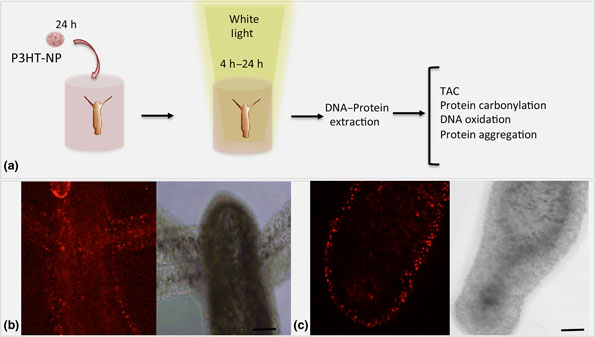Crossref Citations
This article has been cited by the following publications. This list is generated based on data provided by
Crossref.
Lewinska, Anna
Sodagam, Lakshman
Bloniarz, Dominika
Siems, Karsten
Wnuk, Maciej
and
Rattan, Suresh I. S.
2019.
Plant-Derived Molecules α-Boswellic Acid Acetate, Praeruptorin-A, and Salvianolic Acid-B Have Age-Related Differential Effects in Young and Senescent Human Fibroblasts In Vitro.
Molecules,
Vol. 25,
Issue. 1,
p.
141.
Antognazza, Maria Rosa
Abdel Aziz, Ilaria
and
Lodola, Francesco
2019.
Use of Exogenous and Endogenous Photomediators as Efficient ROS Modulation Tools: Results and Perspectives for Therapeutic Purposes.
Oxidative Medicine and Cellular Longevity,
Vol. 2019,
Issue. ,
p.
1.
Wei, Renbo
Gryszel, Maciej
Migliaccio, Ludovico
and
Głowacki, Eric Daniel
2020.
Tuning photoelectrochemical performance of poly(3-hexylthiophene) electrodes via surface structuring.
Journal of Materials Chemistry C,
Vol. 8,
Issue. 31,
p.
10897.
Moros, Maria
Lewinska, Anna
Merola, Francesco
Ferraro, Pietro
Wnuk, Maciej
Tino, Angela
and
Tortiglione, Claudia
2020.
Gold Nanorods and Nanoprisms Mediate Different Photothermal Cell Death Mechanisms In Vitro and In Vivo.
ACS Applied Materials & Interfaces,
Vol. 12,
Issue. 12,
p.
13718.
Abdel Aziz, Ilaria
Malferrari, Marco
Roggiani, Francesco
Tullii, Gabriele
Rapino, Stefania
and
Antognazza, Maria Rosa
2020.
Light-Triggered Electron Transfer between a Conjugated Polymer and Cytochrome C for Optical Modulation of Redox Signaling.
iScience,
Vol. 23,
Issue. 5,
p.
101091.
Ðerek, Vedran
Rand, David
Migliaccio, Ludovico
Hanein, Yael
and
Głowacki, Eric Daniel
2020.
Untangling Photofaradaic and Photocapacitive Effects in Organic Optoelectronic Stimulation Devices.
Frontiers in Bioengineering and Biotechnology,
Vol. 8,
Issue. ,
Zangoli, Mattia
and
Di Maria, Francesca
2021.
Synthesis, characterization, and biological applications of semiconducting polythiophene‐based nanoparticles.
VIEW,
Vol. 2,
Issue. 1,
Monti, Filippo
Manfredi, Giovanni
Palamà, Ilaria Elena
Kovtun, Alessandro
Zangoli, Mattia
D'Amone, Stefania
Ortolani, Luca
Bondelli, Gaia
Szreder, Tomasz
Bobrowski, Krzysztof
D'Angelantonio, Mila
Lanzani, Guglielmo
and
Di Maria, Francesca
2021.
Sterilization of Semiconductive Nanomaterials: The Case of Water‐Suspended Poly‐3‐Hexylthiophene Nanoparticles.
Advanced Healthcare Materials,
Vol. 10,
Issue. 6,
Moccia, Francesco
Antognazza, Maria Rosa
and
Lodola, Francesco
2021.
Towards Novel Geneless Approaches for Therapeutic Angiogenesis.
Frontiers in Physiology,
Vol. 11,
Issue. ,
Gutiérrez-Fernández, Edgar
Ezquerra, Tiberio A.
Rebollar, Esther
Cui, Jing
Marina, Sara
Martín, Jaime
and
Nogales, Aurora
2021.
Photophysical and structural modulation of poly(3-hexylthiophene) nanoparticles via surfactant-polymer interaction.
Polymer,
Vol. 218,
Issue. ,
p.
123515.
Berggren, Magnus
Głowacki, Eric D.
Simon, Daniel T.
Stavrinidou, Eleni
and
Tybrandt, Klas
2022.
In Vivo Organic Bioelectronics for Neuromodulation.
Chemical Reviews,
Vol. 122,
Issue. 4,
p.
4826.
Pitsalidis, Charalampos
Pappa, Anna-Maria
Boys, Alexander J.
Fu, Ying
Moysidou, Chrysanthi-Maria
van Niekerk, Douglas
Saez, Janire
Savva, Achilleas
Iandolo, Donata
and
Owens, Róisín M.
2022.
Organic Bioelectronics for In Vitro Systems.
Chemical Reviews,
Vol. 122,
Issue. 4,
p.
4700.
Feyen, Paul L. C.
Matarèse, Bruno F. E.
Urbano, Laura
Abelha, Thais F.
Rahmoune, Hassan
Green, Mark
Dailey, Lea A.
de Mello, John C.
and
Benfenati, Fabio
2022.
Photosensitized and Photothermal Stimulation of Cellular Membranes by Organic Thin Films and Nanoparticles.
Frontiers in Bioengineering and Biotechnology,
Vol. 10,
Issue. ,
Onorato, Giada
Fardella, Federica
Lewinska, Anna
Gobbo, Federico
Tommasini, Giuseppina
Wnuk, Maciej
Tino, Angela
Moros, Maria
Antognazza, Maria Rosa
and
Tortiglione, Claudia
2022.
Optical Control of Tissue Regeneration through Photostimulation of Organic Semiconducting Nanoparticles.
Advanced Healthcare Materials,
Vol. 11,
Issue. 19,
Roger, Liza M.
Lewinski, Nastassja A.
Putnam, Hollie M.
Roxbury, Daniel
Tresguerres, Martin
and
Wangpraseurt, Daniel
2023.
Nanobiotech engineering for future coral reefs.
One Earth,
Vol. 6,
Issue. 7,
p.
778.
Roger, Liza
Lewinski, Nastassja
Putnam, Hollie
Chen, Shaochen
Roxbury, Daniel
Tresguerres, Martin
and
Wangpraseurt, Daniel
2023.
Nanotechnology for coral reef conservation, restoration and rehabilitation.
Nature Nanotechnology,
Vol. 18,
Issue. 8,
p.
831.
Savva, Achilleas
Hama, Adel
Herrera‐López, Gabriel
Schmidt, Tony
Migliaccio, Ludovico
Steiner, Nadia
Kawan, Malak
Fiumelli, Hubert
Magistretti, Pierre J.
McCulloch, Iain
Baran, Derya
Gasparini, Nicola
Schindl, Rainer
Głowacki, Eric D.
and
Inal, Sahika
2023.
Photo‐Chemical Stimulation of Neurons with Organic Semiconductors.
Advanced Science,
Vol. 10,
Issue. 31,
Markov, Aleksandr
Gerasimenko, Alexander
Boromangnaeva, Annie-Kermen
Shashova, Sofia
Iusupovskaia, Elena
Kurilova, Ulyana
Nikitina, Vita
Suetina, Irina
Mezentseva, Marina
Savelyev, Mikhail
Timashev, Peter
Telyshev, Dmitry
and
Liang, Xing-Jie
2023.
Multilayered organic semiconductors for high performance optoelectronic stimulation of cells.
Nano Research,
Vol. 16,
Issue. 4,
p.
5809.
Zangoli, Mattia
Cantelli, Andrea
Candini, Andrea
Lewinska, Anna
Fardella, Federica
Tino, Angela
Tommasini, Giuseppina
Wnuk, Maciej
Moschetta, Matteo
Perotto, Sara
Lucarini, Marco
Tortiglione, Claudia
Lanzani, Guglielmo
and
Di Maria, Francesca
2023.
Photoreactivity of Thiophene-Based Core@Shell Nanoparticles: The Effect of Photoinduced Charge Separation on In Vivo ROS Production.
The Journal of Physical Chemistry C,
Vol. 127,
Issue. 9,
p.
4672.
Tommasini, Giuseppina
Sol‐Fernández, Susel Del
Flavián‐Lázaro, Ana Cristina
Lewinska, Anna
Wnuk, Maciej
Tortiglione, Claudia
and
Moros, María
2024.
Remote Magneto–Thermal Modulation of Reactive Oxygen Species Balance Enhances Tissue Regeneration In Vivo.
Advanced Functional Materials,




